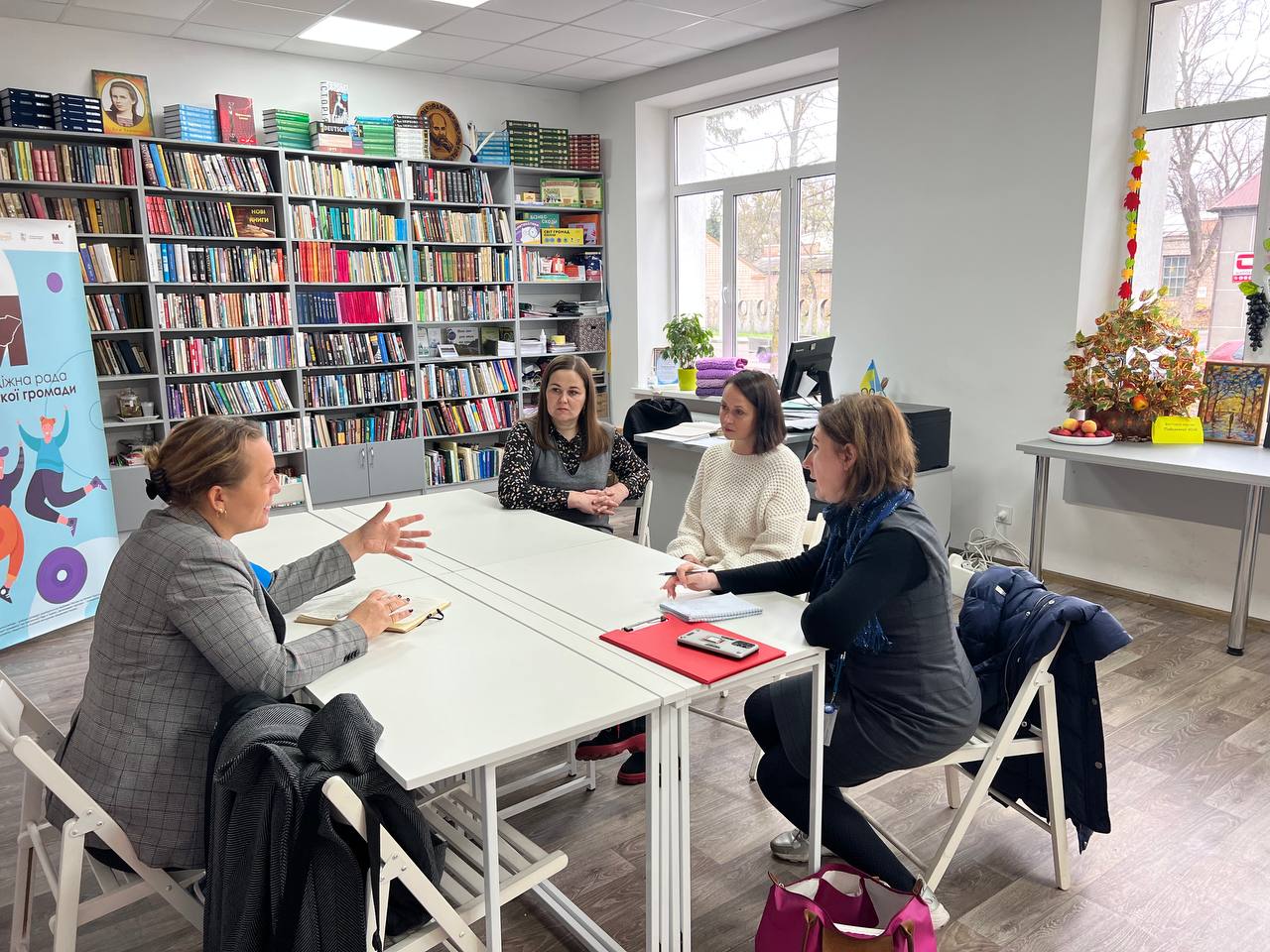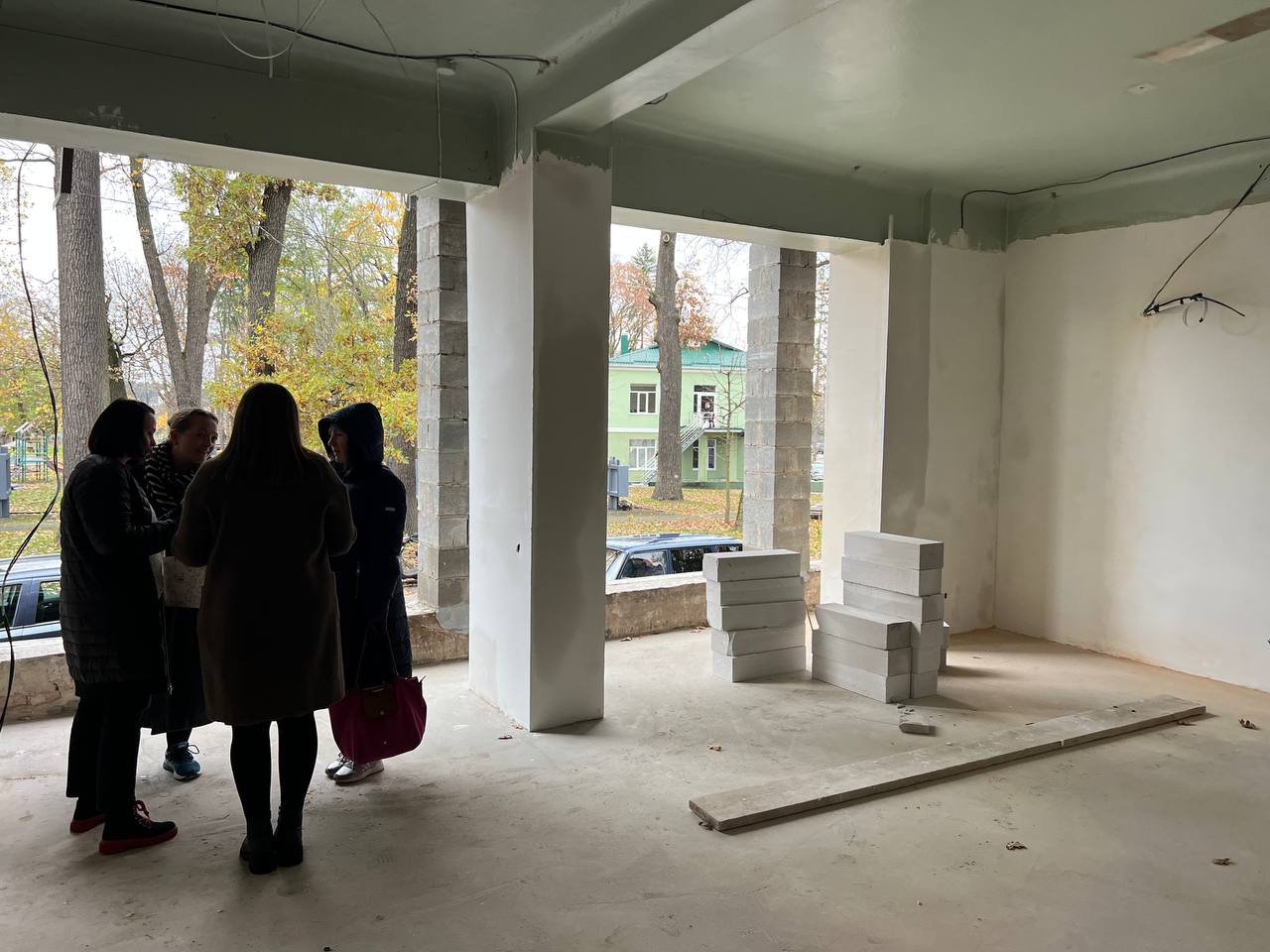“You can’t put life on hold and live in your memories”
“You can’t put life on hold and live in your memories”
Tetiana fled her home and constant shelling in Kharkiv and found solace in Rivne region in western Ukraine, not least through her work in the village council, where she helps other displaced people integrate into their new community.

The construction site looks very much like work in progress. Building materials and tools are spread out on the bare concrete floors between the naked walls, and cool air blows in from the open, window-less gaps to the street.
However, 42-year old Tetiana has a clear vision for this place. Once the construction and refurbishing are done, it will become the first youth center in this district of Rivne region, bringing together children and youth, some of them displaced from across Ukraine because of the war.
“I know from my own experience what are the needs of internally displaced people, especially when it comes to children. They need social life, and soon they can find it here,” she says.
Tetiana would not have imagined herself here two years ago. She was living with her family in Kharkiv, 900 kilometers away, and working as a lawyer. When the escalation of Russia’s war on Ukraine started in February 2022, everything changed dramatically, and Tetiana realized it was impossible for her to stay.
“In the first days of the war, we had to live in the basement or spend the night on the floor in the corridor. The shelling was constant,” she explains, recalling how the family was forced to flee the city after a week’s time.
“The decision was made so quickly and 15 minutes later we left Kharkiv, taking only our documents and our cat with us.”
During the first months, they remained in Kharkiv region, weighing all the pros and cons. Realizing that only online learning would be possible in the region, they decided to go west, in order for her son to be able to attend school physically.
Having heard from a colleague about his hometown of Smyha in the Rivne region, this is where Tetiana and her family ended up – a place where they “could actually sleep at night”. The village is home to around 7,000 inhabitants, and the community currently hosts 120 internally displaced people (IDPs).
The local library serves as a meeting point for social life, bringing together locals and internally displaced people – children as well as adults – explains Iryna Poliova, the director of the village library. At the beginning of the full-scale invasion, when many displaced families arrived, the library transformed into a hub for both distribution of humanitarian aid and a space to connect and engage in activities.
“We had not experienced displacement like this before, but we wanted people to feel safe and comfortable,” says Iryna.
"In places like Smyha, where the distance between houses is considerable, integration into a new community can be very difficult. That is why it is so important with spaces for people to meet and connect.”
Tetiana was immediately impressed by the warmth of the local community and started engaging as a volunteer. That led to the role as Head of IDP council in the local community, and when a job opened as project manager in the village council, Tetiana applied and got the position.
"I realized that I needed to move on with my life. You can't put life on hold and live in your memories, so I was very happy to get a job and be involved in social activities. We received a lot of help and support, and I want to give something back to the community,” she explains.
And now she is giving back, working with her colleagues to establish and manage the youth space, which has just been officially opened in January 2024. It will host various activities and events, and serve as a working area for young entrepreneurs, evolving into a regional center with a youth council.
“It's a pity that these are the circumstances, but I now have friends here, and I really want them to come visit us in Kharkiv when the war is over. For the moment, we have made our peace here, but home is home,” says Tetiana.
Tetiana and other internally displaced people in Smyha village have been supported by UNHCR’s local NGO partner CF Rokada, who has distributed essential aid items, provided psychosocial support, and continues to organize trainings and group activities for both children and adults.
However, 42-year old Tetiana has a clear vision for this place. Once the construction and refurbishing are done, it will become the first youth center in this district of Rivne region, bringing together children and youth, some of them displaced from across Ukraine because of the war.
“I know from my own experience what are the needs of internally displaced people, especially when it comes to children. They need social life, and soon they can find it here,” she says.
Tetiana would not have imagined herself here two years ago. She was living with her family in Kharkiv, 900 kilometers away, and working as a lawyer. When the escalation of Russia’s war on Ukraine started in February 2022, everything changed dramatically, and Tetiana realized it was impossible for her to stay.
“In the first days of the war, we had to live in the basement or spend the night on the floor in the corridor. The shelling was constant,” she explains, recalling how the family was forced to flee the city after a week’s time.
“The decision was made so quickly and 15 minutes later we left Kharkiv, taking only our documents and our cat with us.”
During the first months, they remained in Kharkiv region, weighing all the pros and cons. Realizing that only online learning would be possible in the region, they decided to go west, in order for her son to be able to attend school physically.
Having heard from a colleague about his hometown of Smyha in the Rivne region, this is where Tetiana and her family ended up – a place where they “could actually sleep at night”. The village is home to around 7,000 inhabitants, and the community currently hosts 120 internally displaced people (IDPs).
The local library serves as a meeting point for social life, bringing together locals and internally displaced people – children as well as adults – explains Iryna Poliova, the director of the village library. At the beginning of the full-scale invasion, when many displaced families arrived, the library transformed into a hub for both distribution of humanitarian aid and a space to connect and engage in activities.
“We had not experienced displacement like this before, but we wanted people to feel safe and comfortable,” says Iryna.
"In places like Smyha, where the distance between houses is considerable, integration into a new community can be very difficult. That is why it is so important with spaces for people to meet and connect.”
Tetiana was immediately impressed by the warmth of the local community and started engaging as a volunteer. That led to the role as Head of IDP council in the local community, and when a job opened as project manager in the village council, Tetiana applied and got the position.
"I realized that I needed to move on with my life. You can't put life on hold and live in your memories, so I was very happy to get a job and be involved in social activities. We received a lot of help and support, and I want to give something back to the community,” she explains.
And now she is giving back, working with her colleagues to establish and manage the youth space, which has just been officially opened in January 2024. It will host various activities and events, and serve as a working area for young entrepreneurs, evolving into a regional center with a youth council.
“It's a pity that these are the circumstances, but I now have friends here, and I really want them to come visit us in Kharkiv when the war is over. For the moment, we have made our peace here, but home is home,” says Tetiana.
Tetiana and other internally displaced people in Smyha village have been supported by UNHCR’s local NGO partner CF Rokada, who has distributed essential aid items, provided psychosocial support, and continues to organize trainings and group activities for both children and adults.









